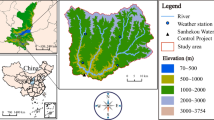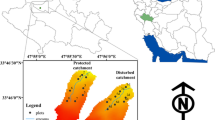Abstract
As a transitional zone between aquatic and terrestrial ecosystems, the riparian buffer is an important control measure for non-point source pollution. The research presented here mainly discussed the interception efficiencies of different vegetation types for nitrogen and phosphorus pollution. The results showed that canopy, shrub, and grass interceptions basically accounted for about 80.0% of total interception, and therefore riparian buffer configurations should clearly distinguish three levels of vegetation types. (1) Canopy, shrub, grass, and litter interceptions of Pinus tabuliformis (YS) were the highest, up to about 71.1%. (2) Platycladus orientalis (CB) had the highest transportation and enrichment for the elements nitrogen (N) and phosphorus (P) throughout the process, which the value of TP decreased from 0.2 to 0.12 mg/L and the value of TN decreased from 5.0 to 2.5 mg/L. (3) The transportation of total phosphorus (TP) of the three tree species was higher than the transportation of total nitrogen (TN), showing that the enrichment of P was stronger than that of N. Thus, Pinus tabuliformis is the best configuration for rainfall interception, while Platycladus orientalis is the best configuration for N and P removals. Different forest configurations should also be considered to build a riparian buffer to remove nutrient in the future.







Similar content being viewed by others
References
Alvarenga LA, Mello CRD, Colombo A, Cuartas LA (2017) Hydrologic impacts due to the changes in riparian buffer in a headwater watershed. Cerne 23:95–102
Baker ME, Weller DE, Jordan TE (2007) Effects of stream map resolution on measures of riparian buffer distribution and nutrient retention potential. Landsc Ecol 22:973–992
Burchsted D, Daniels M, Thorson R, Vokoun J (2010) The river discontinuum: applying beaver modifications to baseline conditions for restoration of forested headwaters. Bioscience 60:908–922
Chen Y (2010) Research on evaluation and controling measure system of agriculture non-point source pollution in Shaanxi Province. Northwest Agric For Univ 6–8
Cooper AB (1990) Nitrate depletion in the riparian zone and stream channel of a small headwater catchment. Hydrobiologia 202:13–26
Dabney LD (1995) Depositional patterns of sediment trapped by grass filter strips during simulated. Trans Am Soc Agric Eng 38:1719–1729
Delgado AN, Periago EL (1995) Vegetated filter strips for wastewater purification: a review. Bioresour Technol 5:113–122
Dillaha TA, Reneau RB, Mostaghimi S, Lee D (1989) Vegetative filterstrips for agricultural nonpoint source pollution control. Trans Am Soc Agric Eng 32:513–519
Environmental Protection Agency of China (1989a) GB 11893–89 water quality-determination of total phosphorus-ammonium molybdate spectrophotometric method. China Standard Press, Beijing
Environmental Protection Agency of China (1989b) GB 11894–89 water quality-determinatlon of total nitrogen-alkaline potassium persulfate digestion-UV spectrophotometric mcthod. China Standard Press, Beijing
Fang SM, Zhao CY, Jian SQ, Yu K (2013) Canopy interception of Pinus tabulaeformis plantation on Longzhong loess plateau, Northwest China: characteristics and simulation. Chin J Appl Ecol 24:1509–1516
Heathwaite AL, Griffiths P, Parkinson RJ (1998) Nitrogen and phosphorus in runoff from grassland with buffer strips following application of fertilizers and manures. Soil Use Manag 14:142–148
Jacobs TC, Gilliam JW (1985) Riparian losses of nitrate from agricultural drainage waters. J Environ Qual 14:472–478
Jon ES, Karl WJ, James JZ (2005) Nutrient attenuation in agro forestry surface runoff by riparian buffer zones in southern Illinois. Agrofor Syst 64:169–180
Klapproth JC, Johnson JE (2000) Understanding the science behind riparian forest buffers: effects on water quality. Va Coop Ext 1–19
Li JY, Zhai HB, Wei XX (2006a) Rainfall and its redistribution ofPinus tabulaeformisand Quercus variabilismixed forests. J Beijing For Univ 28:154–157
Li RH, Guan YT, He M, Hu HY, Jiang ZP (2006b) Pilot-scale study on riparian mixed plant zones treating polluted river water. Environ Sci 27:651–654
Li XF, Chen LH, Yu XX, Zhang Y (2013) Intercept characteristics of typical forest in Beijing severe storm. Agric Sci Guangdong 18:172–173
Lin CY, Chou WC, Lin WT (2002) Modeling the width and placement of riparian vegetated buffer strips: a case study on the Chi-Jia-Wang Stream, Taiwan. J Environ Manag 66:269–280
Liu YY (2013) Characteristics of rainfall interception of vegetations in typical small watershed of black river upstream. Master Thesis Lanzhou Univ.
Liu J, Engel BA, Wang Y, Wu Y, Zhang Z, Zhang M (2019) Runoff response to soil moisture and micro-topographic structure on the plot scale. Sci Rep 9:2532
Lowrance R, Todd R, FaIl J, Hendrickson O, Leonard R, Asmussen L (1984) Riparian forests as nutrient filters in agricultural watersheds. Bioscience 34:374–377
Lowrance R, Mcintyre S, Lanee C (1988) Erosion and deposition in a field/forest system estimated cesium-137 activity. J Soil Water Conserv 43:195–199
Mankin KR, Ngandu DM, Barden CJ, Hutchinson SL, Geyer WA (2007) Grass-shrub riparian buffer removal of sediment, phosphorus, and nitrogen from simulated runoff. J Am Water Resour Assoc 43:1108–1116
Mi Y, He C, Bian H, Cai Y, Sheng L, Ma L (2015) Ecological engineering restoration of a non-point source polluted river in northern China. Ecol Eng 76:142–150
Pang XB (2010) Rainfall interception capacity of regetation in Taihang mountainares. J Hebei For Sci Technol 4:1–8
Parkyn SM, Davies-Colley RJ, Cooper AB, Stroud MJ (2005) Predictions of stream nutrient and sediment yield changes following restoration of forested riparian buffers. Ecol Eng 24:551–558
Parsons JE, Gilliam JW, Munoz-Carpena R, Daniels RB, Dillaha TA (1994) Nutrient and sediment removal by grass and riparian buffers. Am Soc Agric Eng 147–154
Peterjohn WT, Correll DL (1984) Nutrient dynamics in an agricultural watershed: observations on the role of a riparian forest. Ecology 65:1466–1475
Qian JP, Wang RD, Bai J, Zhang GY (2012) Canopy rainfall interception of different planted forests in Taihang mountainous region. Bull Soil Water Conserv
Quan WM, Yan LJ (2002) Effects of agricultural non-point source pollution on eutrophication of water body and its control measure. Acta Ecol Sin 22:291–299
Shen YN (2010) Modeling about non-point source pollution and quantity control for it within watershed. Zhejiang Univ 12
Silva IC, Rodríguez HG (2001) Interception loss, throughfall and stemflow chemistry in pine and oak forests in northeastern Mexico. Tree Physiol 21:1009–1013
State Environmental Protection Administration of China (2007) HJ/T 346–2007 water quality-determination of nitrate-nitrogen-ultraviolet spectrophotometry. China Environmental Science Press, Beijing
Swanson S, Kozlowski D, Hall R, Heggem D, Lin J (2017) Riparian proper functioning condition assessment to improve watershed management for water quality. J Soil Water Conserv 72:168–182
Tang JX, Sun LX, Sun TX, Zhang LH (2012) Research advances on retaining and transformation of N and P and ecological restoration of riparian buffer zone. Ecol Environ Sci 21:1514–1520
Tian S, Luo W, Jia Z, Butalia RS (2010) Temporal variation of over-bank flooding of Wei River and its impact on a riparian wetland in Xi’an. China Hydrol Process 24:1296–1307
Wang L, Zhang GX (2006) Removal of nitrogen and phosphorus in riparian buffer zone of wetland. J Agro-Environ Sci 25:649–652
Wang XY, Zhang YF, Yang O (2009) Cost-effectiveness evaluation and preferring of non-point source pollution control management measures. Ecol Environ Sci 18:540–548
Wu JQ (2011) Different slope buffer zone stagnated runoff and pollutant removal quantitative. J Soil Water Conserv 22:112–117
Wu WQ, Li P, Sun XY, Yu X (2013) Ditsribution traits of precipitation of Pinus tabulaeformis, Quercus variabilis and mixed forest of West Mountains in Beijing. J Northeast For Univ 9:26–29
Xiang C, Weiqi Z, Steward P et al (2016) Spatial-temporal variations of water quality and its relationship to land use and land cover in Beijing, China. Int J Environ Res Publ Health 13(5):449
Xiang L, Xiao Q, Niu J, Dymond S, Mcpherson EG, Doorn NV, XinxiaoYu, Xie B, Zhang K, Jiao L (2017): Rainfall interception by tree crown and leaf litter:an interactive process. Hydrol Process 31
Yan WJ (1999) Transformation and runoff losses of nitrogen and phosphorus in paddy wetlands. J Appl Ecol 10:312–316
Yan Y, Guan Q, Wang M, Su X, Wu G, Chiang P, Cao W (2018) Assessment of nitrogen reduction by constructed wetland based on InVEST: a case study of the Jiulong River Watershed, China. Mar Pollut Bull 133:349–356
Zhang GF (2013) The effects of riparian vegetation buffer zones on nitrogen and phosphorus reduction in Chaobai River upstream. Chin Agric Sci Bull 29:189–194
Zhang P, Zhang XD, Huang LL, Liu WG, Zhu WS, Tang SQ (2009) Interception effect of surface runoff on different width Bambusa rigida Keng riparian buffer strips. J Soil Water Conserv 23:23–27
Zhou BS, Yang XB (2008) Study on simulation of canopy interception in Platycladus orientalis and Quercus mixed woodland. J Hebei For Sci Technol 6:12–15
Funding
This research was supported by the Natural Science Foundation of China (41771547).
Author information
Authors and Affiliations
Corresponding authors
Additional information
Responsible editor: Kenneth Mei Yee Leung
Publisher’s note
Springer Nature remains neutral with regard to jurisdictional claims in published maps and institutional affiliations.
Rights and permissions
About this article
Cite this article
Xu, K., Mo, L., Zhang, Z. et al. Water quantity and quality changes from forested riparian buffer in Beijing. Environ Sci Pollut Res 26, 29041–29051 (2019). https://doi.org/10.1007/s11356-019-05991-5
Received:
Accepted:
Published:
Issue Date:
DOI: https://doi.org/10.1007/s11356-019-05991-5




